For additional information relating to this article, please contact:
August 02, 20172016 CENSUS: FAMILIES, HOUSEHOLDS AND MARITAL STATUS Today, Statistics Canada released data from the 2016 Census on the structure of families and households, as well as marital status. Nationwide, there were 14.1 million private households in 2016, including 9.5 million (67.7 per cent) which contained at least one census family. Census families are defined as married or common-law couples, with or without children, and lone-parent families. All other individuals are considered not to be in a census family. One-person households accounted for 28.2 per cent of households in 2016, the highest in the country's history, having surpassed couples with children as the most common type of household for the first time. The remaining 4.1 per cent of households were made up of two or more people who were not members of a census family, such as roommates or siblings living together.
Across the country, one-person households accounted for the largest share of the total in Quebec (33.3 per cent), Nova Scotia (29.5 per cent) and British Columbia (28.8 per cent), and the smallest share in Alberta (24.0 per cent). From 2001 to 2016, growth in the share of one-person households has increased most in the Atlantic provinces, reflecting the faster aging of the population in the region.
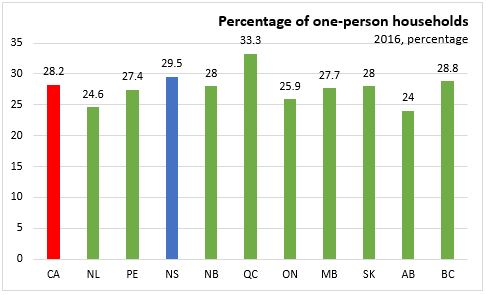
Statistics Canada's Daily article also notes that multigenerational households - those that include at least three generations of the same family - are the fastest growing type of household, though they account for just 2.9 per cent of households in 2016. As well, the number of couples without children is growing faster than those with children. All of these trends - the rise of one-person households, multigenerational households and couples without children - can be interpreted as a result of the aging population. As the large baby boom cohort ages into later stages of life, a growing number of widows and widowers live alone and households headed by baby boomers are increasingly "childless" as their children reach adulthood and move out.
Family Characteristics of Adults

In Nova Scotia in 2016, 256,245 individuals age 15 and over were married or common-law, without children living at home, up 5.7 per cent from 2011, while 191,885 individuals were married or common-law with children, down 6.0 per cent. There were 46,900 lone-parents, up 0.4 per cent from 2011. 105,095 individuals age 15 and over lived in their parents' or grandparents' household, down 6.0 per cent from 2011. There were 174,625 individuals that did not live in census families, including 16,910 living with other relatives (+1.2 per cent), 39,045 living with non-relatives (+4.3 per cent), and 118,675 living alone (+9.1 per cent, the fastest growing category).
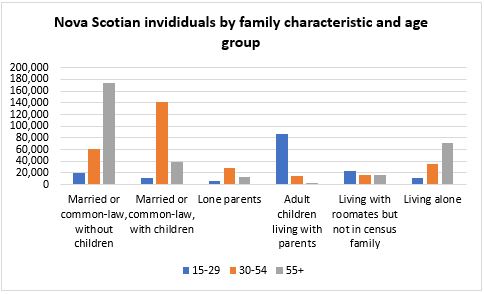
Breaking down each of these categories by age group shows that aging demographic forces are driving the major trends. The majority of individuals that are married or common-law without children at home (68.1 per cent) and those living alone (60.7 per cent) are ages 55 and over, while the majority of those living in couples with children are ages 30 through 54 (73.5).
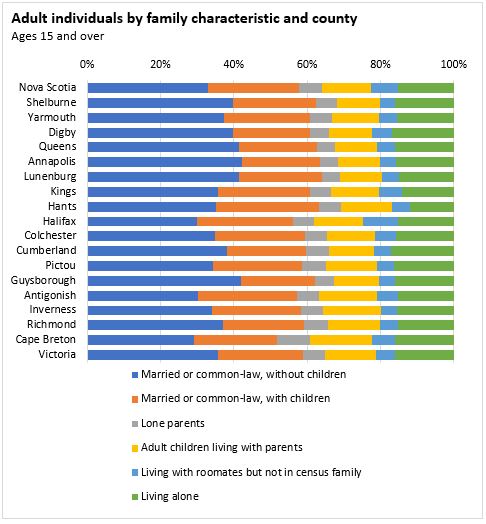
Across the province, the share of individuals by family characteristics differs but not substantially. Individuals living married or common-law without children in their household are generally more prevalent in older counties
Family Characteristics of Children
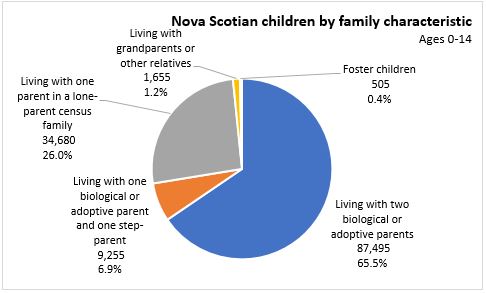
Just under two-thirds (65.5 per cent) of Nova Scotia children (ages 0-14) lived with two biological or adoptive parents in 2016, down from 66.5 per cent in 2011; 26.0 per cent of children lived in a lone-parent family, up from 25.1 per cent in 2011; 6.9 per cent lived with one biological or adoptive parent and one step-parent; 1.2 per cent lived with other relatives and 0.4 per cent lived in foster care.
Marital Status
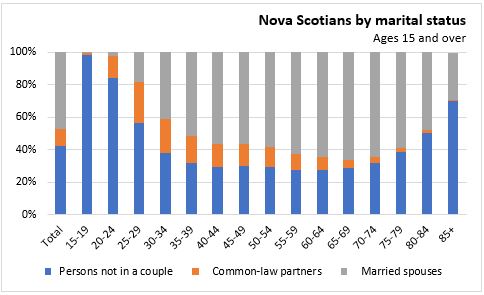
In 2016, 46.8 per cent of Nova Scotians ages 15 and over were married, down from 48.1 per cent in 2011. 42.2 per cent were not married or common-law, up from 41.9 per cent in 2011, and 11.0 per cent were common-law up from 10.0 per cent in 2011. A growing phenomenon, common-law partnering is most common among younger couples, while marriage rates peak in the 65-69 age group.
The 2016 census also offers data on same-sex couples. Of all married or common-law couples in Nova Scotia in 2016, 1.0 per cent, or 4,505 of them, were same-sex couples including 1,765 married couples and 2,740 common-law. Common-law coupling was more common among same-sex couples (60.8 per cent of the total) than among opposite-sex couples (18.6 per cent).
Source: Statistics Canada 2016 Census Daily Article | Tables